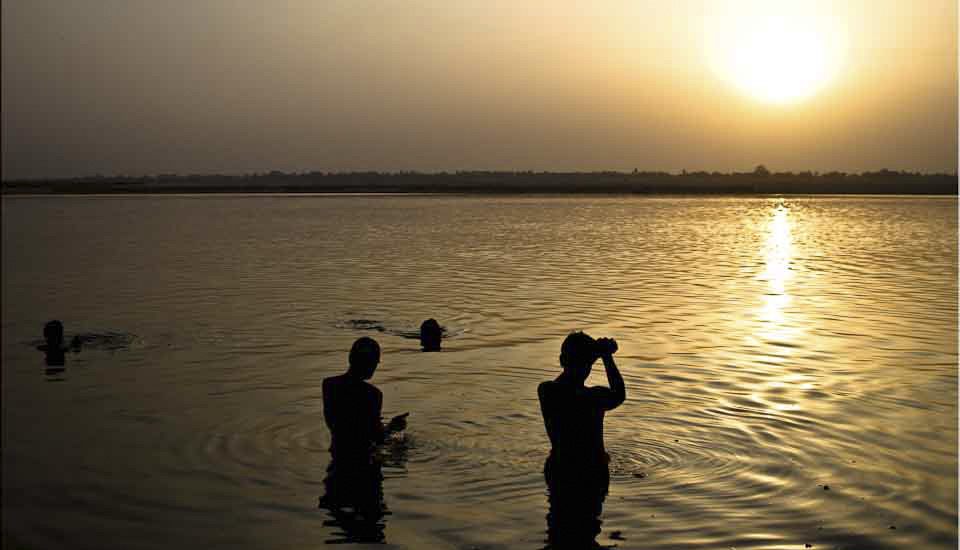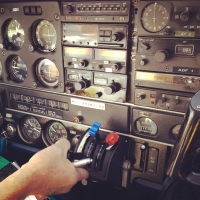.jpg)
Dreams and Reflections
Being on a boat on the Ganges is soporific: the air hums like a high-tension electrical wire in the heat; the smells of incense and pollution envelope you; the oars dip quietly; and the pressing crowd of buildings along the ghats float off into the haze.
From time immemorial, the Ganges has been the holy river of Hinduism.
And, of all the spots on this long river – which rises in the western Himalaya and flows 2,510 km (1560 mi) through India and Bangladesh and into the the Bay of Bengal – the ghats, the steps leading down to the water’s edge, at Varanasi are the most sacred. If you bathe in the goddess Ganga Ma or “Mother Ganges” here at Varanasi, you wash away all your sins. Even better: if you die here, you escape the cycle of reincarnation and achieve instant salvation (see: Life and Death on the Ghats). From pre-dawn until after dark, ritual fires burn in Varanasi to offer prayers and pay tribute to this sacred river.
Even as a non-Hindu, I was captivated by the spirit of the place.
I was travelling with photographers Gavin Gough and Matt Brandon, and because it was a photographic trip, I had plenty of time to wander, soak up the atmosphere, and contemplate life and photographic projects. I had spent the very early hours watching the Hindu priests prepare and conduct their morning aarti – a devotional ritual that uses fire as an offering – for the Goddess Ganga (see: Light the Darkness).
It was still early, but the ghats were already humming with activity. I met my group at Assi Ghat, and we divided up into wooden rowboats for a sedate look at the riverbanks from the water.
It is an experience not to be missed!
.jpg)
Boats off Assi Ghat
We get into our boats near Assi Ghat …
.jpg)
Along the Ghats
… at the very southern end of the Varanasi ghats.

Jain Ghat
Jain Ghat or Bachraj Ghat has three Jain Temples. In Hinduism, the right-facing swastika (卐) symbolises surya, the sun, and brings prosperity and good luck.

Men Bathing
Every day, thousands of people bathe in the Ganges: a ritual dip in the holy waters at Varanasi is said to purify the soul.

Rowboats
The wooden boats are kept busy …

Boats on the Ganges
… with pilgrims and tourists alike.

Washing in the Ganges
You can see some of the rubbish in the background here; it is said that pollution levels in the waters of the Ganges …

Water Colours
… are 3000 times higher than the limits prescribed as safe by the World Health Organization.

Untouchable Kids
Further up the river, near Harishchandra Ghat, the children of the men who manage the cremation pyres hunt for objects in the remains of the fires. In theory, the caste system is no longer legal in India – but the evidence of ongoing practice is everywhere.

The Desolate East Bank
The story goes that if you die on the eastern bank of the Ganges, you will be reborn as a donkey. Certainly, most of the life of the city concentrates on the western side of the river.

Mansarovar Ghat
A bright red guest house makes a colourful landmark atop the steps built by Raja Man Singh of Amber (Jaipur) in 1585.

Boatman
Our boatman was taciturn, and mostly rowed in silence – unlike that of my companions. He kept pointing out bundles bobbing in the water: ‘Sadhu body’. Sadhus are revered as next to the supreme being, and are therefore in the small group of Hindus who do not need fire for purification at death. Instead, they are wrapped in banana leaves and weighted down in the river. They do not always stay down – and can be seen floating away.

Meditation
Time marches differently here; people meditating along the river sit in absolute stillness for long periods.

Candy-Coloured Boats
I love the colours and textures of the boats – especially against the dreamy heat haze of the ghats in the background.

The Eyes of the Boats

Prayag Ghat
This is one of the busiest sections of the ghats – being just left of Dashaswamedh Ghat, …

Boats off Dashashwamedh Ghat
… which the most important section of river in Varanasi. One of the oldest and holiest of the ghats, the famous Ganga aarti takes place here every evening (see: Life and Death).

Yellow Row Boat

Women in the Ghat
While a ritual dip is a spiritual experience, it is also communal – and fun: people are happy to smile at us as we pass in our boat.

More Boats on the Ganges
The rich red sandstone of Maharaja Chet Singh Fort, built by the Raja of Benares in the 1770s, stands out in the background.

Laundry on the Ghat
Long cloths are stretched out along the ghats to dry – hopefully after washing, not dyeing: chemical dyes are only one of the many things polluting this mighty river.
The irony, of course, is that these sacred waters which can save you from eternal rebirth are so polluted that they might also be what kills you. Experts link the pollution in India’s rivers to the country’s high rate of waterborne illnesses, which kill an estimated 1.5 million children every year (e.g.: PBS Ganga River; SMH Holy River from Hell).
While there is a push to clean the river, dropping water levels, the demands of industry and farming, and just the sheer press of humanity, make this an uphill battle.
And, there is a deep belief that as well as being able to cleanse us of our sins, Mother Ganga can look after herself.
Personally, I wouldn’t be surprised if she is feeling rather overwhelmed!
ॐ
Photos: 10April2010


























.jpg)

